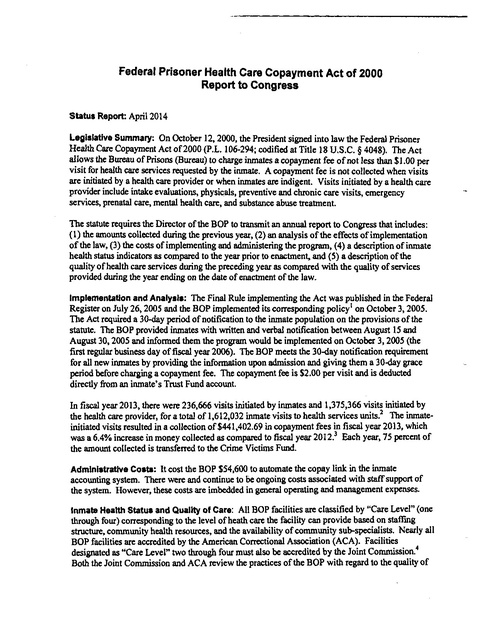Healthcare Copay Report, 2013 - Bureau of Prisons
Download original document:

Document text

Document text
This text is machine-read, and may contain errors. Check the original document to verify accuracy.
Federal Prisoner Health Care Copayment Act of 2000 Report to Congress Status Report: April2014 Legislative Summary: On October 12,2000, the President signed into law the Federal Prisoner Health Care Copayment Actof2000 (P.L. 106-294; codified at Title 18 U.S.C. § 4048). The Act allows the Bureau of Prisons (Bureau) to charge inmates a copayment fee of not less than $1.00 per visit for health care services requested by the inmate. A copayment fee is not collected when visits are initiated by a health care provider or when inmates are indigent. Visits initiated by a health care provider include intake evaluations, physicals, preventive and chronic care visits, emergency services, prenatal care, mental health care, and substance abuse treatment. The statute requires the Director of the BOP to transmit an annual report to Congress that includes: ( 1) the amounts collected during the previous year, (2) an analysis of the effects of implementation of the law, (3) the costs of implementing and administering the program, (4) a description of inmate health status indicators as compared to the year prior to enactment, and (5) a description of the quality of health care services during the preceding year as compared with the quality of services provided during the year ending on the date of enactment of the law. Implementation and Analysis: The Final Rule implementing the Act was published in the Federal Register on July 26, 2005 and the BOP implemented its corresponding policy 1 on October 3, 2005. The Act required a 30-day period of notification to the inmate population on the provisions of the statute. The BOP provided inmates with written and verbal notification between August 15 and August 30, 2005 and infonned them the program would be implemented on October 3, 2005 (the first regular business day of fiscal year 2006). The BOP meets the 30-day notification requirement for all new irunates by providing the infonnation upon admission and giving them a 30-day grace period before charging a copayment fee. The copayment fee is $2.00 per visit and is deducted directly from an inmate's Trust Fund account. In fiscal year 2013, there were 236,666 visits initiated by inmates and 1,375,366 visits initiated by the health care provider, for a total of 1,612,032 inmate visits to health services units? The inmateinitiated visits resulted in a collection of $441,402.69 in copayment fees in fiscal year 2013, which was a 6.4% increase in money collected as compared to fiscal year 2012.3 Each year, 75 percent of the amount collected is transferred to the Crime Victims Fund. Administrative Costa: It cost the BOP $54,600 to automate the copay link in the inmate accounting system. There were and continue to be ongoing costs associated with staff support of the system. However, these costs are imbedded in general operating and management expenses. Inmate Health Status and Quality of Care: All BOP facilities are classified by "Care Level" (one through four) corresponding to the level of heath care the facility can provide based on staffmg structure, community health resources, and the availability of community sub-specialists. Nearly all BOP facilities are accredited by the American Correctional Association (ACA). Facilities 4 designated as "Care Level" two through four must also be accredited by the Joint Commission. Both the Joint Commission and ACA review the practices of the BOP with regard to the quality of health care, patients' rights, and patient access to care. During the past year, all of the BOP facilities accredited by these two organizations maintained their accreditations. All indicators of morbidity and mortality demonstrate that the health status of inmates in BOP custody has not changed significantly since the implementation of the Inmate Copayment Program. All indicators of quality of health care demonstrate that the quality of medical care provided to inmates in the custody of the BOP has not been impacted by the implementation of the Inmate Copayment Program. A review of the complaints regarding the Inmate Copa~ent Program filed by inmates during the past year through the Administrative Remedy Program revealed that inmates received the care that was necessary to meet their medical needs and that the copayment was collected appropriately. The review also showed no appreciable change in the rate or types of complaints regarding the delivery of health care over the past year. Notes: 1. BOP Program Statement P6031.02 titled "Inmate Copayment Program." 2. Copayment fees are not collected from visits initiated by health care providers. However, it should be noted that the number of provider-initiated visits reported in 2013 is significantly higher than in prior years. This appears to be the result of improved reporting rather than a dramatic increase in actual visits initiated by health care providers in 2013. On June 25,2012, copay visit information began to be automatically transmitted to trust fund accounts via the Bureau's Electronic Medical Record (BEMR). Previously, health services staff were required to log on to a separate system to key the visits, both paid and non-paid, into the trust fund system. This resulted in an under-reporting of provider-initiated visits in the past. 3. A copayment fee is charged for all inmate-initiated visits except those within the 30-day grace period and visits initiated by indigent inmates. 4. The Joint Commission, formerly known as the Joint Commission on Accreditation ofHealthcare Organizations (JCAHO), is an independent, not-for-profit organization that accredits and certifies more than 18,000 health care organizations and programs in the United States. 5. The Administrative Remedy Program provides inmates with a means to seek redress of complaints or formal review of issues relating to their confinement. It allows the BOP to examine its policies, programs, operations, and procedures based on inmates' claims and to make changes when necessary.





